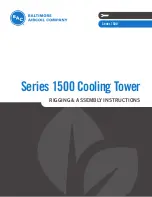
Page 13 of 84
Section 3:
Installer Responsibility:
The installer is responsible for the following:
• To install and commission the unit, as well as the
fuel and electrical supplies, in accordance with
applicable specifications and codes. Addison
recommends the installer contact a local building
inspector for guidance.
• To use the information given in a layout drawing and
in the manual together with the cited codes and
regulations to perform the installation.
• To furnish all needed materials not furnished as
standard equipment.
• To plan location of supports.
• To provide access to unit for servicing.
• To provide the owner with a copy of this Installation,
Operation and Service Manual.
• To ensure there is adequate air circulation around the
unit and to supply air for combustion, ventilation and
distribution in accordance with local codes.
• To assemble or install any accessories or associated
duct work using best building practices.
• To properly size supports and hanging materials.
• To verify that the unit is delivering design airflow by
having an air balancing test performed.
• To have refrigerant technician certification per
Section 608 of the US Environmental Protection
Agency (EPA) Clean Air Act of 1990 or equivalent
certification program.
• To have all required equipment to work on direct
expansion and/or chilled water air conditioning system.
3.1 Corrosive Chemicals
Addison cannot be responsible for ensuring that all
appropriate safety measures are undertaken prior to
installation; this is entirely the responsibility of the installer.
It is essential that the contractor, the subcontractor, or the
owner identifies the presence of combustible materials,
corrosive chemicals or halogenated hydrocarbons*
anywhere in the premises.
* Halogenated Hydrocarbons
are a family of chemical compounds
characterized by the presence of halogen elements (fluorine,
chlorine, bromine, etc.). These compounds are frequently used in
refrigerants, cleaning agents, solvents, etc. If these compounds
enter the air supply of the burner, the life span of the unit
components will be greatly reduced. An outside air supply must
be provided to the burners whenever the presence of these
compounds is suspected. Warranty will be invalid if the unit is
exposed to halogenated hydrocarbons.
WARNING
EXPLOSION HAZARD
Equipment must have access to
uncontaminated air at all times.
Failure to follow these instructions
can result in death, injury, or
property damage.
CAUTION
PRODUCT DAMAGE HAZARD
Do not use equipment in area
containing corrosive materials.
Refer to appropriate Material
Safety Data Sheets (MSDS).
Failure to follow these instructions
can result in product damage.
3.2 Required Equipment and Materials
When lifting of the unit is required, the installing
contractor is responsible for supplying or arranging for
the appropriate lifting equipment so that the unit may be
placed in a safe manner.
The qualified installing / service technician is responsible
for having the appropriate equipment and materials for the
safe installation and start-up of an unit. Tools and materials
required to commission the unit include, but are not limited
to, the following:
• Various screwdriver types and sizes
• Various wrench types and sizes
• Drill motor and various drill bits
• Voltmeter
• Clamp style ammeter
• Butyl caulk
• Gauges and accessories
• Direct expansion and/or chilled water gauges
and accessories.
PR Series Installation, Operation, and Maintenance Manual














































